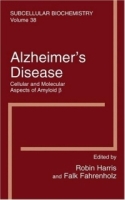| Alzheimer's Disease: Cellular and Molecular Aspects of Amyloid beta (Subcellular Biochemistry) артикул 13815d. |
 |
Book Description Preface: To understand Alzheimer’s disease (AD) is one of the major thrusts of present-day clinical research, strongly supported by more fundamental cellular, biochemical, immunological and structural studies It is these latter that receive attention within this book This compilation of 20 chapters indicates the diversity озред of work currently in progress and summarizes the current state of knowledge Experienced authors who are scientifically active in their fields of studyhave been selected as contributors to this book, in an attempt to present a reasonably complete survey of the field Inevitably, some exciting topics for one reason or another have not been included, for which we can only apologize Standardization of terminology is often a problem in science, not least in the Alzheimer field; editorial effort has been made to achieve standardazation between the Chapters, but some minor yet acceptable personal / author variation is still present, i e ß-amyloid/amyloid-ß; Aß42/Aß1-42/Aß1-42! The book commences with a broad survey of the contribution that the range of available microscopical techniques has made to the study of Alzheimer’s amyloid plaques and amyloid fibrillogenesis This chapter also serves as an Introduction to the book, since several of the topics introduced here are expanded upon in later chapters Also, it is significant to the presence of this chapter that the initial discovery of brain plaques,by Alois Alzheimer, utilized light microscopy, a technique that continues to be extremely valuable in present-day AD research Then follow 19 further chapters dealing with interesting areas of research that have a bearing upon Alzheimer’s disease The authors present their own data within the context of a review of related work from others in their field of study Transgenic mouse models for AD are increasingly important and widely used, as is the understanding of the enzymology and biochemistry of amyloid ß production from the amyloid precursor protein (APP) by the ß- and g -secretases, and the non-amyloidogenic APP cleavage products due to a -secreatases Similarly, discussion of the enzymes responsible for the natural degradation of amyloid-ß is included Oxidative stress in AD and the possible protective role of vitamin E have emerged as highly significant topics Likewise, the role of the metals, aluminium copper and zinc in AD is thoroughly addressed, along with the possible value of metal chelation Current concepts as to the fundamental importance of amyloid-ß oligomers versus Aß fibrillar deposits (diffuse and senile plaques) in the pathogenesis of AD is presented, along with the likely role of tissue and cellular cholesterol in the promotion of Aß fibrillogenesis, and Congo red binding to Aß fibrils Several naturally occurring human proteins have the ability to bind to Aß and are found in AD diffuse and senile plaques ApolipoproteinE4, clusterin (ApoJ) and acetylcholinesterase are considered in depth The direct effects of Aß on neuronal membranes, in terms of neuronal membrane fluidity changes and calcium ion transport are dealt with, then the role of amyloid inhibitors and ß-sheet breaking drugs is included The likely important beneficial effects of the cholesterol-lowering drugs, the statins, in lowering brain Aß and consequently the therapeutic prevention of AD by reducing Aß deposition in plaques is discussed thoroughly Finally, an exciting new concept is advanced, namely the possible significance of phosphorylated Aß in Alzheimer’s disease From in vitro experiments Aß phosphorylation appears to increase the proportion of Aß oligomeric forms, an observation which correlates with a the higher cytotoxicity of this species, compared to non-phosphorylated Aß The editors hope that this book will be of interest and value to both medical and scientific research communities working on AD, and to others with a more general interest in the understanding of this devastating neurodegenerative disorder of the elderly Prof J Robin Harris Prof Falk Fahrenholz University of Mainz August, 2004. Кольцо, серебро2004 г 409 стр ISBN 0387232257. |